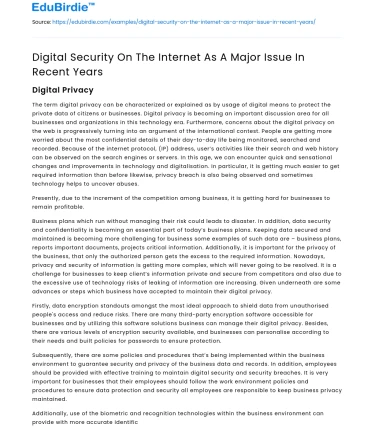Introduction
In the rapidly evolving digital landscape, security on the internet has emerged as a predominant concern, garnering attention from individuals, corporations, and governments alike. As the world becomes increasingly interconnected, the potential risks associated with digital security breaches have grown exponentially. Cybercriminals are constantly refining their tactics, exploiting vulnerabilities in systems to steal sensitive information, disrupt services, and cause economic harm. This essay explores the critical importance of digital security in recent years, examining the multifaceted challenges it presents and the measures being implemented to mitigate these risks. By delving into specific examples and real-life cases, the essay highlights the urgency of addressing this issue and considers counterarguments to offer a comprehensive view of the current digital security landscape.
Growing Threats in the Cyber Realm
The proliferation of internet usage has coincided with a stark increase in cyber threats, making digital security a paramount issue. According to a report by Cybersecurity Ventures, cybercrime is expected to cost the world $10.5 trillion annually by 2025, up from $3 trillion in 2015. This exponential growth in cybercrime underscores the vulnerabilities inherent in modern digital infrastructures. One notable instance is the 2017 Equifax data breach, where the personal information of 147 million Americans was compromised, resulting in significant financial and reputational damage. This breach exemplifies the far-reaching consequences of inadequate digital security measures and highlights the need for robust protective strategies.
Save your time!
We can take care of your essay
- Proper editing and formatting
- Free revision, title page, and bibliography
- Flexible prices and money-back guarantee
Transitioning from individual cases, it is essential to consider the broader implications of cyber threats on national security. In recent years, state-sponsored cyberattacks have become more prevalent, with countries targeting each other's critical infrastructure. The 2020 SolarWinds attack, allegedly backed by Russian intelligence, infiltrated numerous US government agencies and private companies, showcasing the sophisticated nature of modern cyber threats. Such incidents emphasize the complexity of digital security challenges and the necessity for international cooperation and stringent security protocols to safeguard sensitive information and maintain global stability.
Strategies for Enhancing Digital Security
In response to escalating cyber threats, various strategies have been adopted to enhance digital security. One effective measure is the implementation of advanced encryption techniques to protect data. Encryption transforms data into a secure code, making it inaccessible to unauthorized users. The use of end-to-end encryption by companies like WhatsApp and Signal ensures that only the intended recipient can access the message content, providing a robust layer of security against interception. Additionally, the adoption of multi-factor authentication (MFA) has gained traction, requiring users to provide multiple forms of verification before accessing sensitive information. MFA significantly reduces the likelihood of unauthorized access, as it relies on something the user knows (password), something the user has (phone), and something the user is (biometric).
While technological advancements play a crucial role in enhancing digital security, human factors must also be addressed. Cybersecurity training and awareness programs are vital in educating individuals and organizations about potential threats and safe online practices. According to a study by IBM Security, human error is responsible for 95% of cybersecurity breaches, underscoring the need for comprehensive education initiatives. By fostering a culture of security awareness, organizations can empower employees to recognize and respond to potential threats, thereby reducing the risk of breaches.
Challenges and Counterarguments
Despite the advancements in digital security measures, challenges persist, necessitating a balanced perspective. One argument against the current focus on digital security is the potential infringement on privacy rights. Critics argue that certain security measures, such as extensive data monitoring and surveillance, may infringe upon individual privacy. Edward Snowden's revelations about the National Security Agency's surveillance practices sparked global debates about the balance between security and privacy. It is crucial to ensure that security measures do not compromise fundamental human rights, and this can be achieved through transparent policies and accountability mechanisms.
Another counterargument is the potential for security fatigue among users. With the increasing complexity of security protocols, users may become overwhelmed and complacent, inadvertently compromising security. Organizations must strive to implement user-friendly security measures that do not burden users with excessive requirements. Striking a balance between robust security and user convenience is essential in maintaining effective digital protection without alienating users.
Conclusion
In conclusion, digital security on the internet remains a major issue, driven by the escalating frequency and sophistication of cyber threats. The need for robust security measures is underscored by high-profile breaches and the potential impact on national security. While technological advancements such as encryption and multi-factor authentication enhance protection, addressing human factors through education and awareness is equally crucial. However, it is imperative to balance security measures with privacy rights and user convenience to ensure a comprehensive and sustainable approach. As the digital landscape continues to evolve, ongoing vigilance and adaptation are essential to safeguard against emerging threats and protect the integrity of the internet as a vital global resource.






 Stuck on your essay?
Stuck on your essay?

